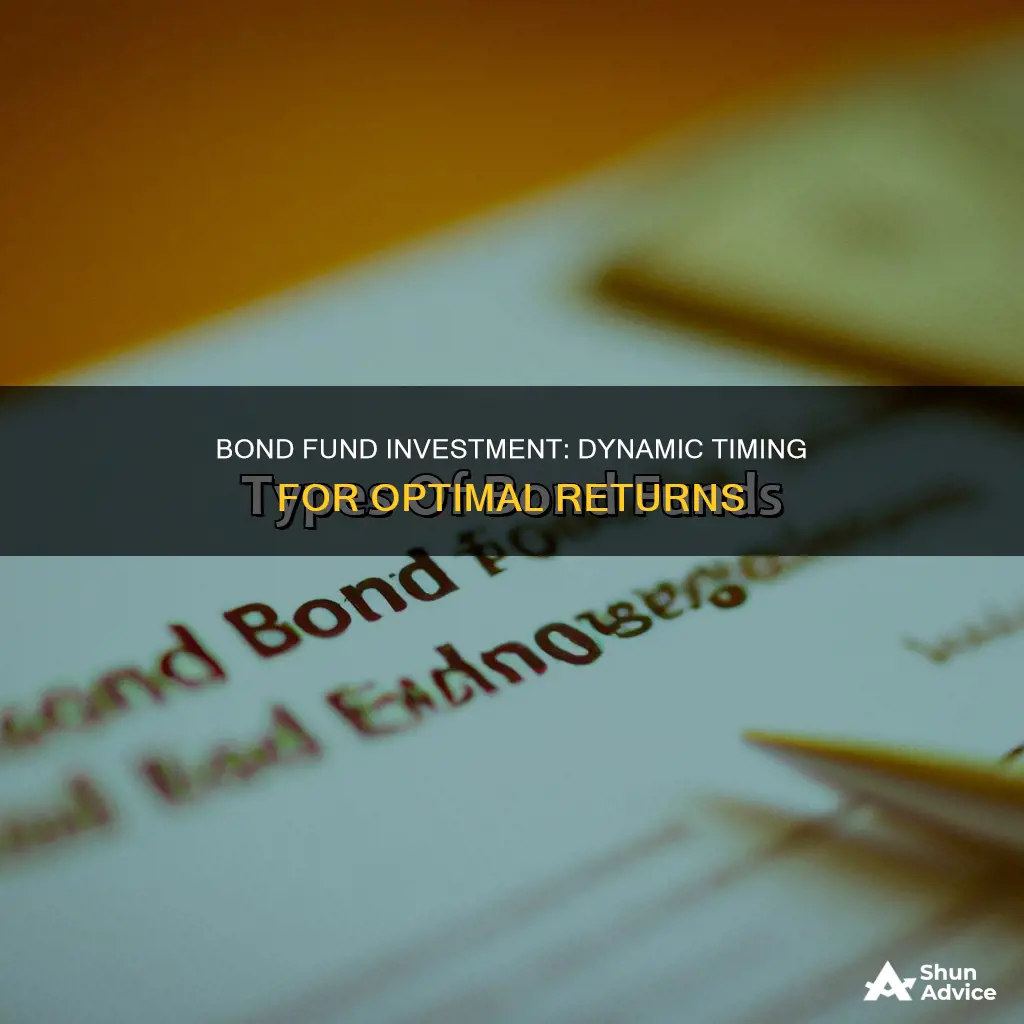
Dynamic bond funds are a class of debt mutual funds that adjust allocations between short-term and long-term bonds based on changing interest rates. They are designed to help investors take advantage of fluctuating interest rates. Dynamic bond funds are ideal for investors who are not experts in making the right calls based on interest rate movements. Dynamic bond funds are considered an all-weather investment option, making them perfect when there is no clarity on the future movement of interest rates.
| Characteristics | Values |
|---|---|
| Type of Fund | Debt mutual fund |
| Management | Fund managers |
| Returns | Optimal returns in both rising and falling market scenarios |
| Investment Horizon | 3-5 years |
| Risk | Moderate |
| Taxation | Short-term capital gains are taxed at the individual's income tax slab rate; long-term capital gains are taxed at 20% with indexation benefit |
| Performance | Depends on the fund manager's ability to read the direction of interest rates |
| Interest Rates | Dynamic bond funds are ideal when interest rates are expected to go up |
| Fund Selection | Assess the credit quality of underlying assets, risk matrix, and past record of the fund and fund manager |
| Macroeconomic Factors | Oil prices, fiscal deficit, and new government policies |
| Additional Income | Dynamic bond funds can be a good source of additional income |
| Historical Performance | Assess the fund's performance over at least five years |
| Modified Duration | Investors should consider the modified duration of the fund and ensure it matches their investment horizon |
What You'll Learn
- Dynamic bond funds are ideal when interest rates are expected to rise
- Dynamic bond funds are designed to mitigate interest rate volatility
- Dynamic bond funds are considered an 'all-weather' debt fund
- Dynamic bond funds are suitable for investors with a medium-term horizon
- Dynamic bond funds are slightly riskier than other debt funds

Dynamic bond funds are ideal when interest rates are expected to rise
Dynamic bond funds are a class of debt mutual funds that can adjust allocations between short-term and long-term bonds. This strategy helps take advantage of fluctuating interest rates. Dynamic bond funds are ideal when interest rates are expected to rise because they are designed to tide over interest rate volatility.
Dynamic bond fund managers have the freedom to invest across securities and maturities depending on their outlook. If a fund manager expects the rates to go up, they can shift investments from long-term to shorter-maturity papers to minimise the impact of rate hikes on investments.
Dynamic bond funds are considered an "all-weather" debt fund and can be recommended to investors with a medium-term horizon. Investors with moderate risk tolerance and a 3-5 year horizon can consider investing in dynamic bond funds.
Dynamic bond funds are slightly riskier than other debt funds. However, they can also deliver higher returns compared to other debt funds.
Invest in Mutual Funds: Cut Out the Middleman
You may want to see also

Dynamic bond funds are designed to mitigate interest rate volatility
Dynamic bond funds are managed by fund managers who have the freedom to invest across securities and maturities depending on their outlook. If a fund manager expects interest rates to rise, they can shift investments from long-term to shorter-maturity papers to minimise the impact of rate hikes on investments. This flexibility can lead to potentially higher returns compared to traditional debt funds.
For example, during a falling interest rate scenario, a fund manager may increase holdings in long-term instruments like gilts. Conversely, if interest rates are expected to rise, a fund manager may opt for shorter-term securities to reduce the risk of capital losses on long-term bonds.
Dynamic bond funds are ideal for investors who are not experts in predicting interest rate movements. Investors with a moderate risk appetite and an investment horizon of 3-5 years should consider these funds. Dynamic bond funds are considered an "all-weather" debt fund and can be recommended to investors with a medium-term horizon.
Invest Wisely: Strategies for Your Child's College Fund
You may want to see also

Dynamic bond funds are considered an 'all-weather' debt fund
Dynamic bond funds are considered an all-weather debt fund. They are a class of debt mutual funds that adjust allocations between short-term and long-term bonds based on changing interest rates. This strategy helps take advantage of fluctuating interest rates.
Dynamic bond funds are ideal for investors who are not experts in predicting interest rate movements. They are also suitable for those with a moderate risk appetite and an investment horizon of 3-5 years.
The main objective of dynamic bond funds is to provide optimal returns in both rising and falling market conditions. The fund manager's ability to read the direction of interest rates is crucial to the performance of these funds. Dynamic bond funds can be more volatile than other debt funds, but they can also deliver higher returns.
Dynamic bond funds are free from the usual debt fund mandate, which requires funds to adhere to a specific investment mandate. For example, short-term bond funds can only invest in short-term securities. However, dynamic bond funds can invest in long-term securities for a month or more, depending on the interest rate movement.
Fund selection is an important aspect when investing in dynamic bond funds. Due to the broad flexibility given to fund managers, the quality and tenure of underlying papers can differ across schemes. As an investor, it is essential to assess the credit quality of underlying assets and the risk matrix of the fund to determine if it suits your risk profile.
A Guide to Investing in Foreign Mutual Funds from India
You may want to see also

Dynamic bond funds are suitable for investors with a medium-term horizon
Dynamic bond funds are a type of debt mutual fund that can be ideal for investors with a medium-term investment horizon. These funds are designed to be flexible and dynamic in terms of their composition and maturity profile, allowing fund managers to adapt to changing market conditions.
One of the key advantages of dynamic bond funds is their ability to alter allocations between short-term and long-term bonds based on fluctuating interest rates. This strategy enables fund managers to optimise returns in both rising and falling markets. For example, during a period of falling interest rates, a fund manager may increase holdings in long-term instruments like gilts, while in an environment with rising interest rates, they can shift investments to shorter-term maturities to minimise the impact of rate hikes.
The flexibility of dynamic bond funds makes them suitable for investors with a medium-term horizon, typically ranging from 3 to 5 years. This time frame allows investors to balance the risks and rewards of the fund. Dynamic bond funds are particularly attractive to those who are not experts in predicting interest rate movements, as the fund managers have the expertise to navigate these complexities.
When considering dynamic bond funds, it is essential to assess the fund's performance over at least five years and evaluate how well it has limited downside risks during periods of rising interest rates. Additionally, investors should remember that returns in dynamic bond funds are heavily influenced by interest rate movements and the fund manager's ability to make timely decisions.
In summary, dynamic bond funds offer a dynamic investment strategy that can provide optimal returns across varying market conditions. They are well-suited for investors with a medium-term investment horizon, who can tolerate moderate risk and are seeking to benefit from the fund manager's expertise in navigating interest rate fluctuations.
Vanguard vs Fidelity: Where to Invest?
You may want to see also

Dynamic bond funds are slightly riskier than other debt funds
Dynamic bond funds are a class of debt mutual funds that adjust allocations between short-term and long-term bonds based on changing interest rates. They are designed to help investors navigate fluctuating interest rates and aim to provide optimal returns in both rising and falling market conditions.
While dynamic bond funds offer an attractive investment strategy, they are slightly riskier than other debt funds. This is because they depend heavily on the fund manager's ability to make the right calls based on interest rate movements. If the fund manager misreads the direction of interest rates or the RBI takes an unexpected step, profits can be significantly impacted.
To illustrate, in 2017, many funds suffered reduced profits when the RBI took a step contrary to the expectations of fund managers. This highlights the crucial role of the fund manager's view on interest rates and the potential consequences if their predictions are inaccurate.
Additionally, dynamic bond funds are exposed to macroeconomic risks, such as oil prices, fiscal deficits, and new government policies, which can also affect returns. It is recommended that investors stay invested for extended periods to minimize short-term risks.
Furthermore, dynamic bond funds differ from other debt funds in terms of tax efficiency. Due to potential shifts in the interest cycle, investing in dynamic bonds may result in a higher tax incidence. This is an important consideration for investors looking to maximize their after-tax returns.
Overall, while dynamic bond funds offer the potential for higher returns, they also come with slightly higher risks. Investors considering dynamic bond funds should carefully assess their risk tolerance, investment horizon, and the track record of the fund and its manager before making a decision.
Strategies to Attract Hedge Fund Investment
You may want to see also







